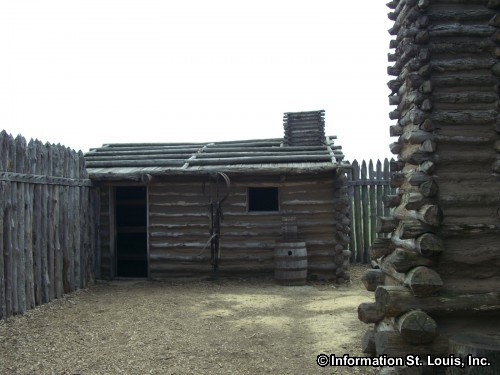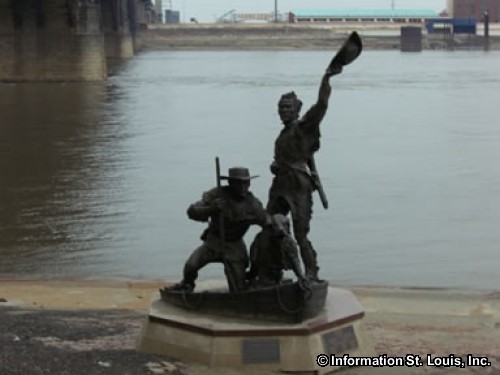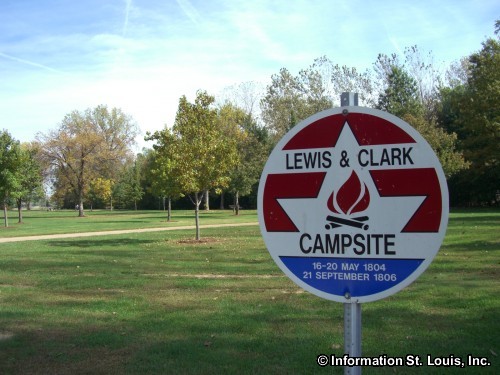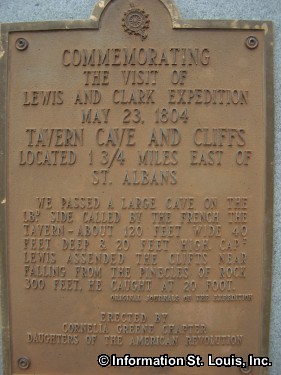The Lewis and Clark Expedition

Several important exploration expeditions of the newly purchased Louisiana Territory left from St. Louis. Lt. Zebulon M. Pike was sent out on two expeditions. One in 1805, to find and explore the headwaters of the Mississippi River. The other, in 1806, to explore the headwaters of the Arkansas River and to find the source for the Red River. On both expeditions he left from Fort Belle Fontaine. The fort was built in 1805 and was the first US Military Post located west of the Mississippi River. The site is located in what is now Fort Bellefontaine Park, a park in the St. Louis County Parks system.
Lewis and Clark Expedition
The most well know expedition to leave from St. Louis was that of Meriwether Lewis and William Clark. In 1803, Lewis and Clark where sent by President Thomas Jefferson to discover if a water route from the Mississippi River to the Pacific Ocean could be found. The expedition was also asked to explore the newly acquired land of the Louisiana Purchase and to learn about the people, plants and animals of this new land. Interestingly, none of the men that were asked to go had any scientific background so had to acquire those skills. Skills which included map making (Cartography), plant (Botany) and animal (Zoology) identification and knowledge of weather conditions (Meteorology). These scientific skills distinguishes the Lewis and Clark journey of discovery from other expeditions of this time. Most explorers were not equipped with these skills, thus not much was learned about the land that those explorers traveled through.
Stops Along the Missouri River
 Having arrived in St. Louis in December 1803, Lewis and Clark and their exploration party made their winter camp across the Mississippi at Camp River Dubois, near what is now Hartford Illinois. This camp was important in that it enabled Lewis and Clark to acquire supplies for the journey and to find the men who would accompany them on the journey. It also was an opportunity for the men to train and become a military unit that comprised the Corps of Discovery.
Having arrived in St. Louis in December 1803, Lewis and Clark and their exploration party made their winter camp across the Mississippi at Camp River Dubois, near what is now Hartford Illinois. This camp was important in that it enabled Lewis and Clark to acquire supplies for the journey and to find the men who would accompany them on the journey. It also was an opportunity for the men to train and become a military unit that comprised the Corps of Discovery.
On May 14, 1804, Lewis and Clark and the men of the Corps of Discovery launched their keel boat and two pirogues near the confluence of the Mississippi and Missouri Rivers. The expedition would travel several miles up the Missouri river each day and would then make camp along the river. On May 15th, the expedition made camp across from Coldwater Creek, the location that would become Fort Belle Fontaine the following year. The next stop was at St. Charles Missouri on May 16th and the exploration party stayed through May 20th. They camped in what is now Frontier Park in St. Charles. Another campsite, on May 22, 1804, was located along what is now Weldon Spring Conservation Area at an island called Tavern Island which, because of the changing of the river channel, would eventually disappear and re-emerge as what is now Howell Island. On May 23, 1804, the expedition passed by the Daniel Boone Home and settlement and would stop 1 3/4 miles east of what is now the community of St. Albans Missouri. While exploring the area, Meriwether Lewis almost lost his life when he fell from the 300 foot high bluff atop Tavern Rock Cave. Luckily for him, and for the continuation of the expedition, he was able to stop his fall by digging his knife into the earth.
Other stops were made near what are now the communities of Washington Missouri on May 24th and Marthasville Missouri on May 25th. Their journey continued on up the Missouri River and would eventually last almost 2 1/2 years, taking them over 8,000 miles and would become one of the most remarkable information gathering expeditions of the time. The return journey ended in St. Louis Missouri on September 23, 1806 after stopping on the day before in the newly built Fort Belle Fontaine.
Lewis and Clark After the Expedition
When Lewis and Clark returned to St. Louis, they both stayed in the area. In 1807, President Jefferson appointed William Clark the Indian Agent for the Louisiana Territory and brigadier general of its militia. In 1813 when the Missouri Territory was formed from the Louisiana Territory, Clark was appointed its governor by President Madison. Missouri became a state in 1820 but Clark did not win the governors election so was returned to a position in Indian affairs. He was made Superintendent of Indian Affairs at St. Louis in 1822. When William Clark died in 1838, he was buried in the Bellefontaine Cemetery, located north of St. Louis.
Meriwether Lewis was appointed the Governor of the Louisiana Territory by President Jefferson and he assumed the office in 1808. He was not in office long when controversy over how he managed government funds caused him to travel to Washington, DC to give an explanation of his actions. On his way, he and his three travel companions stopped overnight at Grinder's Stand, an inn on the Natchez Trace which was a well traveled trail, located in Tennessee. During the night, shots rang out and Lewis was found shot several times. He died on October 11, 1809 and was buried in a graveyard nearby. The site is now the Meriwether Lewis National Monument located near Hohenwald Tennessee. President Jefferson, Clark and others believed that Lewis had committed suicide because of the stress he was under, but some believe he was murdered.
Commemorating the Lewis and Clark Expedition

The St. Louis Gateway Arch along with the Museum of Westward Expansion, the Old Cathedral, and the Old Courthouse make up the Jefferson National Expansion Memorial which commemorates the Lewis and Clark Expedition and the role of St. Louis as the "Gateway to the West." Several other local sites commemorate the Lewis and Clark Expedition: the Lewis and Clark Confluence Tower located near the confluence of the Mississippi and Missouri Rivers in Hartford Illinois; the Lewis and Clark Boathouse and Nature Center located in St. Charles Missouri near Frontier Park; and, as noted before, Camp River Dubois, the Lewis and Clark Illinois State Historic Site, located in Hartford Illinois. The Missouri History Museum houses many artifacts from the Expedition, as well.
Lewis and Clark Expedition Photo Gallery

The fort at Camp River Dubois Link

Lewis and Clark Boat House and Museum Link

Lewis and Clark Statue on the St Louis Riverfront St Louis Riverfront

Captian's quarters at Camp River Dubois Link

Frontier Park-a Lewis and Clark Expedition Historic Site Link

Lewis and Clark Boat House and Museum Link

The 6-pound cannon in Fort Bellefontaine Park Link

A replica of the Lewis and Clark keel boat-Camp River Dubois Link

Camp Dubois-the launching point of the Lewis and Clark Expedition Link
Hey There! Do You Know What Your Home Is Worth Today?
Check Here Now!Events in St Louis History
Have You Considered A Career In Real Estate?
Learn MORE Here!St Louis Missouri Real Estate For Sale
New Construction For Sale: 1320
Condos For Sale: 697
Commercial For Sale: 1799
Acreage For Sale: 1263
Multi-Family 5+ For Sale: 103
Multi-Family 2-4 For Sale: 444
Lots For Sale: 3089
Total Properties For Sale: 18240








